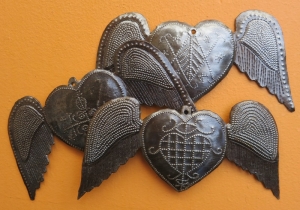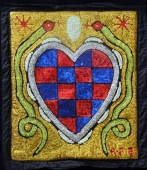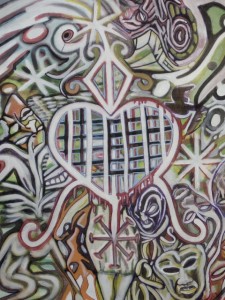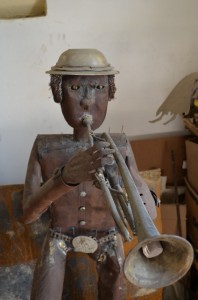The Truth about Veves
They say that to be forewarned is to be forearmed. With that in mind, I’m hoping you will find the following information, hip, cool, enlightening, or some combination thereof, but I will forewarn you that it may – despite my intentions – simply freak you out. Are you ready? These cute little winged hearts are detailed with voodoo veve symbols.
Voodoo beliefs encompass rada, or benevolent spirits, and petro spirits, which are anything but. To mix the metaphor, they are the yin and yang of voodoo culture. This is purely an issue of balance, though somewhat unfairly, Petro spirits get a disproportionate amount of the hype. The veve on the heart in front (photo left) symbolizes the spirit of Erzulie Freda, the spirit of love, and a rada spirit, if ever there was one. How perfectly appropriate that her veve should adorn a metal heart with wings. Not so freaky, right?
Veves appear on many of our Haitian pieces, on the flags, on paintings, and on the metal too. What is a veve, actually, and what purpose does it serve? Worthy questions, both. The short answer, according to Milo Rigaud, who is an expert on such things is this: “Veves represent figures of the astral forces. In the course of Vodoo ceremonies, the reproduction of the astral forces represented by the veves obliges the spirits to descend to earth.” This begs the further
question: What is an astral force? I hope you love the following definition as much as I did when I consulted the Cambridge Dictionary. It said, “Astral forces are those forces pertaining to the stars and are beyond human comprehension.” Ah, mystery.
Every voodoo spirit, benevolent or otherwise, has its own unique veve symbol. In ceremonies, the veve of the spirit whose presence is desired is sprinkled on the floor with cornmeal or colored sand. Personally, I have observed veves arranged in stone on the floors of voodoo temples. In either case, they are a visual supplication, used to summon the presence of a particular spirit. In art, they are representational symbols of honor.
So what’s the verdict? Not freaky at all, but very hip, cool and enlightening? Oh, I hope so!
Contributed by Linda for Its Cactus



![sm355[1]](https://blog.itscactus.com/wp-content/uploads/2012/12/sm35511-218x300.jpg)

